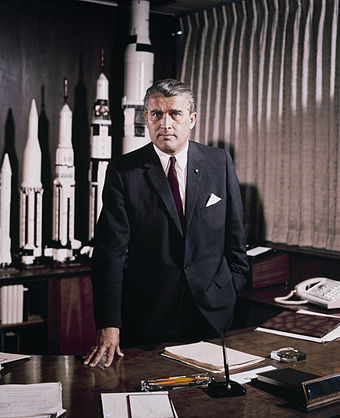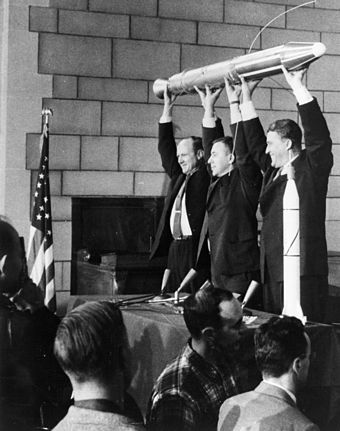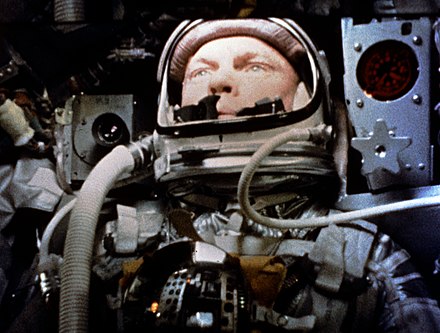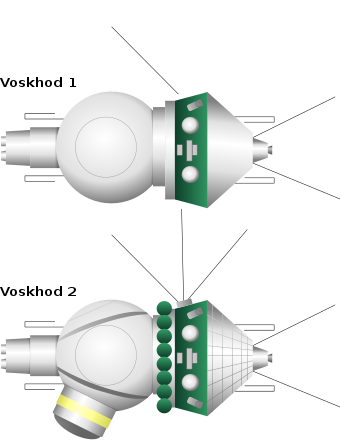The Space Race was an informal 20th-century competition between two Cold War rivals, the Soviet Union (USSR) and the United States (US), to achieve firsts in spaceflight capability. It had its origins in the ballistic missile-based nuclear arms race between the two nations following World War II. The technological advantage required to rapidly achieve spaceflight milestones was seen as necessary for national security, and mixed with the symbolism and ideology of the time. The Space Race led to pioneering efforts to launch artificial satellites, uncrewed space probes to the Moon, Venus, and Mars, and human spaceflight in low Earth orbit and to the Moon.[1] The competition began in earnest on August 2, 1955, when the Soviet Union responded to the US announcement four days earlier of intent to launch artificial satellites for the International Geophysical Year, by declaring they would also launch a satellite "in the near future". The Soviet Union achieved the first successful launch with the October 4, 1957, orbiting of Sputnik 1, and sent the first human to space with the orbital flight of Yuri Gagarin on April 12, 1961. The USSR also sent the first woman, Valentina Tereshkova, to space on June 16, 1963, with numerous other firsts taking place over the next few years with regards to flight duration, spacewalks and related activities. According to Russian sources, these achievements led to the conclusion that the USSR had an advantage in space technology in the early 1960s.[2] According to US sources, the "race" peaked with the July 20, 1969, US landing of the first humans on the Moon with Apollo 11. Most US sources will point to the Apollo 11 lunar landing as a singular achievement far outweighing any combination of Soviet achievements. The USSR attempted several crewed lunar missions, but eventually canceled them and concentrated on Earth orbital space stations, while the US landed several more times on the Moon.[3][4][5][6] A period of détente followed with the April 1972 agreement on a co-operative Apollo–Soyuz, resulting in the July 1975 rendezvous in Earth orbit of a US astronaut crew with a Soviet cosmonaut crew and co-developing the enabling docking standard APAS-75. Though cooperation had been pursued since the very beginning of the Space Age, Apollo–Soyuz eased the competition to enable later cooperation.[7] The end of the Space Race and competition is not clear cut, since the Apollo 11 Moon landing and the ASTP have been identified as such,[8] but with the December 1991 dissolution of the Soviet Union it was ultimately replaced through increased spaceflight cooperation with the APAS enabled Shuttle–Mir and International Space Station programs between the US and the newly founded Russian Federation.[9][10] The Space Race has left a technology legacy of increased space related development and advances. It sparked increases in spending on education and research and development, which led to many spin-off effects[11][12] such as the NASA Technology Transfer Program.[13][14]
Early rocket development
Germany during World War II
The origins of the Space Race can be traced to Germany, beginning in the 1930s and continuing during World War II when Nazi Germany researched and built operational ballistic missiles capable of sub-orbital spaceflight.[15] Starting in the early 1930s, during the last stages of the Weimar Republic, German aerospace engineers experimented with liquid-fueled rockets, with the goal that one day they would be capable of reaching high altitudes and traversing long distances.[16] The head of the German Army's Ballistics and Munitions Branch, Lieutenant Colonel Karl Emil Becker, gathered a small team of engineers that included Walter Dornberger and Leo Zanssen, to figure out how to use rockets as long-range artillery in order to get around the Treaty of Versailles' ban on research and development of long-range cannons.[17] Wernher von Braun, a young engineering prodigy, was recruited by Becker and Dornberger to join their secret army program at Kummersdorf-West in 1932.[18] Von Braun dreamed of conquering outer space with rockets and did not initially see the military value in missile technology.[19] During the Second World War, General Dornberger was the military head of the army's rocket program, Zanssen became the commandant of the Peenemünde army rocket center, and von Braun was the technical director of the ballistic missile program.[20] They led the team that built the Aggregat-4 (A-4) rocket, which became the first vehicle to reach outer space during its test flight program in 1942 and 1943.[21] By 1943, Germany began mass-producing the A-4 as the Vergeltungswaffe 2 ("Vengeance Weapon" 2, or more commonly, V2), a ballistic missile with a 320 kilometers (200 mi) range carrying a 1,130 kilograms (2,490 lb) warhead at 4,000 kilometers per hour (2,500 mph).[22] Its supersonic speed meant there was no defense against it, and radar detection provided little warning.[23] Germany used the weapon to bombard southern England and parts of Allied-liberated western Europe from 1944 until 1945.[24] After the war, the V-2 became the basis of early American and Soviet rocket designs.[25][26] At war's end, American, British, and Soviet scientific intelligence teams competed to capture Germany's rocket engineers along with the German rockets themselves and the designs on which they were based.[27] Each of the Allies captured a share of the available members of the German rocket team, but the United States benefited the most with Operation Paperclip, recruiting von Braun and most of his engineering team, who later helped develop the American missile and space exploration programs. The United States also acquired a large number of complete V2 rockets.[25]
Soviet rocket development
The German rocket center in Peenemünde was located in the eastern part of Germany, which became the Soviet zone of occupation. On Stalin's orders, the Soviet Union sent its best rocket engineers to this region to see what they could salvage for future weapons systems.[28] The Soviet rocket engineers were led by Sergei Korolev.[28] He had been involved in space clubs and early Soviet rocket design in the 1930s, but was arrested in 1938 during Joseph Stalin's Great Purge and imprisoned for six years in Gulag.[29] After the war, he became the USSR's chief rocket and spacecraft engineer, essentially the Soviet counterpart to von Braun.[30] His identity was kept a state secret throughout the Cold War, and he was identified publicly only as "the Chief Designer."[30] In the West, his name was only officially revealed when he died in 1966.[30] After almost a year in the area around Peenemünde, Soviet officials conducted Operation Osoaviakhim and later moved more than 170 of the top captured German rocket specialists to Gorodomlya Island on Lake Seliger, about 240 kilometers (150 mi) northwest of Moscow.[31] They were not allowed to participate in final Soviet missile design, but were used as problem-solving consultants to the Soviet engineers.[32] They helped in the following areas: the creation of a Soviet version of the A-4; work on "organizational schemes"; research in improving the A-4 main engine; development of a 100-ton engine; assistance in the "layout" of plant production rooms; and preparation of rocket assembly using German components.[31] With their help, particularly Helmut Gröttrup's group, Korolev reverse-engineered the A-4 and built his own version of the rocket, the R-1, in 1948.[33] Later, he developed his own distinct designs, though many of these designs were influenced by the Gröttrup Group's G4-R14 design from 1949.[33] The Germans were eventually repatriated in 1952–53.[33] Details of the German achievements and potential contributions to the Soviet rocket and space program were evaluated after their return from Gorodomlya.[34]
American rocket development
The American professor Robert H. Goddard had worked on developing solid-propellant rockets since 1914, and demonstrated a light battlefield rocket to the US Army Signal Corps only five days before the signing of the armistice that ended World War I. He also started developing liquid-propellant rockets in 1921, yet he had not been taken seriously by the public.[35] Von Braun and his team were sent to the United States Army's White Sands Proving Ground, located in New Mexico, in 1945.[36] They set about assembling the captured V2s and began a program of launching them and instructing American engineers in their operation.[37] These tests led to the first photos of Earth from space, and the first two-stage rocket, the WAC Corporal-V2 combination, in 1949.[37] The German rocket team was moved from Fort Bliss to the Army's new Redstone Arsenal, located in Huntsville, Alabama, in 1950.[38] From here, von Braun and his team developed the Army's first operational medium-range ballistic missile, the Redstone rocket, that in slightly modified versions, launched both America's first satellite, and the first piloted Mercury space missions.[38] It became the basis for both the Jupiter and Saturn family of rockets.[38]
Cold War missile race
The Cold War (1947–1991) developed between two former allies, the Soviet Union and the United States, soon after the end of the Second World War. It involved a continuing state of political conflict, military tension, proxy wars, and economic competition, primarily between the Soviet Union and its satellite states (often referred to as the Eastern Bloc) and the powers of the Western world, particularly the United States.[39] The primary participants' military forces never clashed directly, but expressed this conflict through military coalitions, strategic conventional force deployments, extensive aid to states deemed vulnerable, proxy wars, espionage, propaganda, a nuclear arms race, and economic and technological competitions, such as the Space Race.[39] In simple terms, the Cold War could be viewed as an expression of the ideological struggle between communism and capitalism.[40] The United States faced a new uncertainty beginning in September 1949, when it lost its monopoly on the atomic bomb.[40] American intelligence agencies discovered that the Soviet Union had exploded its first atomic bomb, with the consequence that the United States potentially could face a future nuclear war that, for the first time, might devastate its cities.[40] Given this new danger, the United States participated in an arms race with the Soviet Union that included development of the hydrogen bomb, as well as intercontinental strategic bombers and intercontinental ballistic missiles (ICBMs) capable of delivering nuclear weapons.[40] A new fear of communism and its sympathizers swept the United States during the 1950s, which devolved into paranoid McCarthyism.[40] With communism spreading in China, Korea, and Eastern Europe, Americans came to feel so threatened that popular and political culture condoned extensive "witch-hunts" to expose communist spies.[40] Part of the American reaction to the Soviet atomic and hydrogen bomb tests included maintaining a large Air Force, under the control of the Strategic Air Command (SAC). SAC employed intercontinental strategic bombers, as well as medium-bombers based close to Soviet airspace (in western Europe and in Turkey) that were capable of delivering nuclear payloads.[41] For its part, the Soviet Union harbored fears of invasion. Having suffered at least 27 million casualties during World War II after being invaded by Nazi Germany in 1941,[42] the Soviet Union was wary of its former ally, the United States, which until late 1949 was the sole possessor of atomic weapons. The United States had used these weapons operationally during World War II, and it could use them again against the Soviet Union, laying waste to its cities and military centers.[42] Since the Americans had a much larger air force than the Soviet Union, and the United States maintained advance air bases near Soviet territory, in 1947 Stalin ordered the development of intercontinental ballistic missiles (ICBMs) in order to counter the perceived American threat.[32] In 1953, Korolev was given the go-ahead to develop the R-7 Semyorka rocket, which represented a major advance from the German design. Although some of its components (notably boosters) still resembled the German G-4, the new rocket incorporated staged design, a completely new control system, and a new fuel. It was successfully tested on August 21, 1957, and became the world's first fully operational ICBM the following month.[43] It was later used to launch the first satellite into space, and derivatives launched all piloted Soviet spacecraft.[44] The United States had multiple rocket programs divided among the different branches of the American armed services, which meant that each force developed its own ICBM program. The Air Force initiated ICBM research in 1945 with the MX-774.[45] However, its funding was cancelled and only three partially successful launches were conducted in 1947.[45] In 1950, von Braun began testing the Air Force PGM-11 Redstone rocket family at Cape Canaveral.[46] In 1951, the Air Force began a new ICBM program called MX-1593, and by 1955 this program was receiving top-priority funding.[45] The MX-1593 program evolved to become the Atlas-A, with its maiden launch occurring June 11, 1957, becoming the first successful American ICBM.[45] Its upgraded version, the Atlas-D rocket, later served as a nuclear ICBM and as the orbital launch vehicle for Project Mercury and the remote-controlled Agena Target Vehicle used in Project Gemini.[45] With the Cold War as an engine for change in the ideological competition between the United States and the Soviet Union, a coherent space policy began to take shape in the United States during the late 1950s.[47] Korolev took inspiration from the competition as well, achieving many firsts to counter the possibility that the United States might prevail.[48]



















